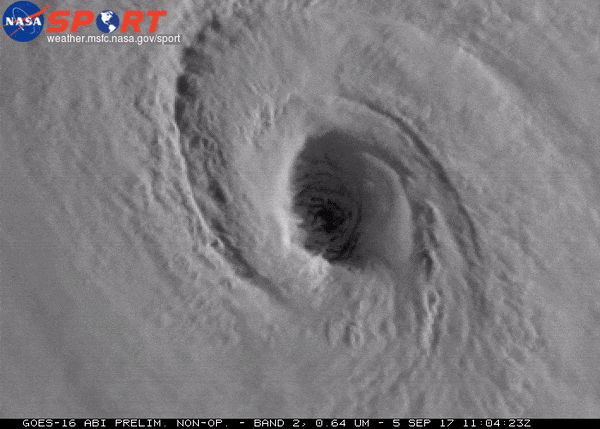Irma was downgraded to a tropical storm Monday morning, but the storm still has the capability to bring heavy downpours and destructive winds to much of the southeastern United States.
Irma made a second landfall at Marco Island in southwest Florida at 3:35 p.m. ET on Sunday as a category 3 hurricane.
History of Hurricane #Irma: 1 September 2017 – 10 September 2017 #GOES16 pic.twitter.com/Z53paEmpIY
— NASA SPoRT (@NASA_SPoRT) September 11, 2017
The storm is moving north with destructive 70 mile per hour (110 km/h) winds as it’s expected to continue moving north-northwest out of Florida and into southwest Georgia and Alabama from Monday into Tuesday.
#Irma has been downgraded to a Tropical Storm, but is still capable for dangerous winds. No more hurricane warnings https://t.co/TsWsNxZWCA pic.twitter.com/TXcj7AL4S8
— WESH 2 News (@WESH) September 11, 2017
Irma’s first landfall was at Cudjoe Key in the Florida Keys at 9:10 a.m. ET on Sunday morning.
Current tropical storm warnings
Because Irma has been downgraded to a tropical storm, warnings have been changed from hurricane to tropical storm.
The NHC has issued a tropical storm warning for the following areas:
- Bonita Beach to the Okaloosa/Walton County Line
- Jupiter Inlet to the South Santee River
- Lake Okeechobee
Deadly storm surge
Storm surge estimates range from 4-6 feet. Southwest Florida from Captiva to Cape Sable is slated to have the highest, with tapering amounts heading northward up Gulf and Atlantic coasts.
Current storm surge warnings include:
- South Santee River southward to the Flagler/Volusia County line
- Cape Sable northward to the Ochlockonee River
- Tampa Bay
Inland threat
As the storm weakens over land, Irma will bring tropical storm force winds (39-73 mph) and up to 8 inches of rain as far north as western North Carolina. Tropical storm warnings have been issued as far north as Atlanta.
With Irma’s remnants continuing to march inland, wide swaths of power outages are occurring and still expected. Officials expect power restorations to last for weeks.
Given the widespread damaging winds yesterday, downed trees and power lines will continue to be an issue. https://t.co/J2K7C9z82w
— NWS Atlanta (@NWSAtlanta) September 12, 2017
UPDATE: There are approximately 800K customers without power. Pls visit https://t.co/Q1gIGDlLqD to track estimate restoration times.
— Georgia Power (@GeorgiaPower) September 12, 2017
US preparations
States of emergency have been issued for the entire states of Georgia, Florida, South Carolina and North Carolina.
Mandatory evacuations were ordered for the entire Florida Keys beginning early Wednesday.
In Florida, several low-lying areas near the coast have issued mandatory evacuations for certain zones and barrier islands.
In Georgia, mandatory evacuations have been ordered for all areas east of Interstate 95, including Chatham County, along with some areas west of I-95.
Florida Governor Rick Scott on Thursday ordered all K-12 public schools and state colleges to close until Monday to allow for more space for shelters. Several school districts in Georgia, along with the University of Georgia & Georgia Southern have announced closures through at least Tuesday.
Limited air travel
Air transportation continues to be limited throughout the southern US and the Caribbean. The West Palm Beach Airport is scheduled to reopen at noon today, with Fort Lauderdale and Tampa’s airports expected to be closed at least through Monday. Miami International Airport will reopen on Tuesday with limited operations after the airport suffered some water damage.
— Fort Lauderdale-Hollywood Int'l Airport (FLL) (@FLLFlyer) September 11, 2017
Flights have already resumed at Providenciales airport in the Turks & Caicos, according to a statement posted to the airport’s Facebook page.
Nearly 1,000 flights have been canceled in Atlanta today, with Southwest Airlines canceling all flights after 1 p.m. today. Delta has also canceled 900 flights Monday out of its main hub, citing “strong crosswinds that exceed operating limits.”
“As is the case at all airports, Atlanta’s five runways are aligned with the prevailing wind, which generally blows from the east or west. Aircraft are best suited to take off and land into the wind for better performance. When the wind direction is perpendicular to the runway, it’s called a crosswind and can make landing challenging and potentially unsafe. A slight crosswind is allowable and can be safely managed, but a 40 mph or greater crosswind, as the storm is expected to bring in Atlanta, may exceed allowable limits.”
Delta, in a statement
However, Delta will operate a humanitarian flight to bring in recovery supplies to St. Thomas, Virgin Islands on Monday with 150 U.S. citizens taking a return flight to Atlanta. Delta says that they will fly more humanitarian flights in the Caribbean throughout the week.
Key messages from the National Hurricane Center
- There is the danger of life-threatening storm surge flooding along portions of the coasts of Florida, Georgia and South Carolina, where a Storm Surge Warning remains in effect.
- Irma will continue to bring life-threatening wind impacts to much of central and north Florida, with hurricane-force winds near the center. Also, Irma is a large hurricane, and hurricane-force wind gusts and sustained tropical-storm force winds extend far from the center. Wind hazards from Irma will continue to spread northward through Georgia and into portions of Alabama, Tennessee, South Carolina, and North Carolina.
- Irma continues to produce very heavy rain and inland flooding across much of the northern peninsula and eastern panhandle of Florida and southern Georgia, which is quickly spreading to the rest of the southeast United States. Intense rainfall rates of 2 inches or more per hour is leading to flash flooding and rapid rises on creeks, streams, and rivers. Significant river flooding is likely over the next five days in the Florida peninsula and southern Georgia, where average rainfall totals of 8 to 15 inches are expected. Significant river flooding is possible beginning Monday and Tuesday in much of central Georgia and southern South Carolina where average rainfall of 3 to 6 inches and isolated 10 inch amounts are expected. Portions of these states within the southern Appalachians will be especially vulnerable to flash flooding. Farther north and west, Irma is expected to produce average amounts of 2 to 4 inches in parts of Mississippi, Alabama, and Tennessee, northern South Carolina and western North Carolina, where isolated higher amounts and local flooding may occur.
NHC forecast discussion, 5AM ET September 11
A record-setting storm
With a minimum pressure of 914 millibars recorded on early on September 6, Irma now has the lowest pressure recorded in the Atlantic outside of the Gulf of Mexico or western Caribbean.





